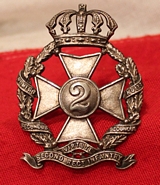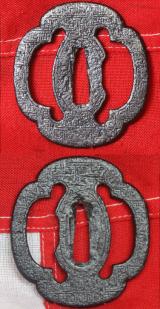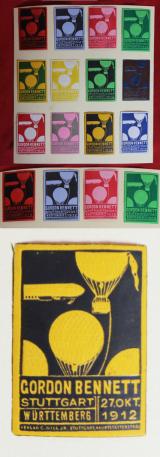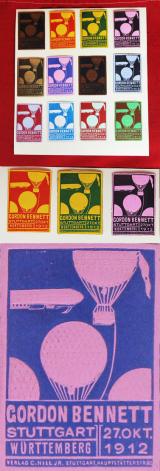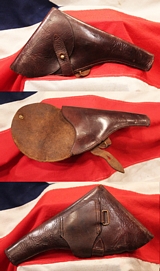A Very Good, Antique, Edo Period 1700's, Wakazashi Maru Gata Heianjo Tsuba
Antique Japanese Edo period tsuba for wakizashi sword or large o-tanto
Fine engraved with gold and high quality brass inlay Heianjo-style that was established in Yamashiro (Kyoto Pref. today). It was inspired by the Ounin-style.
Heianjo tsuba are elaborate and most decorative. It is mainly iron tsuba, of circular shape with brass inlay. Its designs were simply family crests, or arabesque patterns in the beginning. However, as time past they made different shapes of tsuba and started using gold, silver, or copper for inlaying.
The tsuba, is a fundamental element in the mounting of the Japanese sword, it is the guard, the most important element of the fittings, and has two main functions: the first to protect the hand against the slashes and lunges of an opposing sword; the second is to prevent that the hand ends up directly on the cutting edge of the blade. Over the course of more than ten centuries of history, the tsuba has undergone a number of important changes, as regards the materials used for its manufacture and its appearance.
During the centuries of wars that characterised Japan until the advent of the Tokugawa Shogunate during the first half of the 17th century, the tsuba was essentially made of iron or steel. From the mid-17th century onwards the tsuba became a real work of art, with the use of soft metals used in various ways, with engravings, incrustations; well made tsuba were the pride of hundreds of craftsmen’s schools whose value sometimes exceeded that of the same blades of the mounting where tsuba was part of.
66mm across. read more
375.00 GBP
Front Page of the Evening News Sept 6th 1938. 'Hitler's First Message', From the Nuremberg Rally
A most intriguing original historical souvenir of Hitler's National Socialist pre-war Germany in 1938 during his rise to power, and the start of his imminent move to all out total war, and the destruction of freedom throughout all Europe.
5-12 September 1938. Nuremberg. The last X Party Rally called ‘Reichsparteitag Großdeutschland’ (The Congress of Great Germany) once again praised the triumphs of the Third Reich, including the Annexation of Austria six months before. The grand opening was accompanied by Wagner’s ‘Meistersinger von Nürnberg’ opera to inspire Hitler himself and Goebbels with enthusiasm. This Party Congress was the last of that kind as the XI Rally, pre-planned as the “The Party Conference of Peace” for September 1939 was denied on the threshold of the invasion of Poland.
Nürnberg Rally, the massive Nazi Party rallies held in 1923, 1927, and 1929 and annually from 1933 through 1938 in Nürnberg (Nuremberg) in Bavaria. The rallies were primarily propaganda events, carefully staged to reinforce party enthusiasm and to showcase the power of National Socialism to the rest of Germany and the world.
The emotional power generated by the rallies has been preserved in films, most notably in Leni Riefenstahl’s classic Triumph des Willens (1935; Triumph of the Will), which presents a carefully orchestrated version of the 1934 rally.
The paper has discoloured areas and the left hand side is hand torn, but its interest in a historical context more that makes up for it. It would be ideal for framing read more
95.00 GBP
A Rare Victorian 2nd Regiment NSW Volunteer Infantry Helmet Badge Circa
Circa 1878. Silvered brass hat badge with centrally mounted Maltese cross featuring a number '2' within a circle in the centre. The cross is surmounted by a large Kings Crown and surrounded by a wreath of waratahs with intertwined scrolls. The scroll on the left reads 'NUMERO SECUNDUS' and the right scroll reads 'NULLI SECUNDUS'. Beneath the cross on a central scroll is 'VIRTUTE' and 'SECOND REGT INFANTRY'. The back of the badge has three lugs for attaching it to the hat. They have a near identical example in the Australian War Memorial Collection that may be associated with the Ferguson family from Goulburn as it was found in the personal affects of 9146 Gunner Leopold Ferguson who was killed on 9 June 1917 while serving with the Australian Imperial Force. read more
295.00 GBP
1929 Graf Zeppelin Round the World, Meissen Medal. Beaded Rim in Caramel Brown Bisque Porcelain with Gold Edge
From a small collection of most rare Meissen porcelain medals of the Graf Zeppelin round the world flight. three different variations of the same medal. Perfect for either early aviation and airship collectors, rare medal collectors, or collectors of finest German porcelain from the Weimar period
1929 GERMANY. 1929 Graf Zeppelin World Flight Medal. Red Porcelain, 50.7mm. Mint condition.
Obv. Airship over Eastern
Hemisphere globe, GRAF ZEPPELIN WELT
RUNDFLUG . Rev. Airship over Western Hemisphere globe, FRIEDRICHSHAFEN. TOKIO. LOS ANGELES. LAKEHURST . A classic Zeppelin
issue made by the State Porcelain Factory of Meissen, mintmark crossed swords, Kurschwertern . MEISSEN TABLE MEDAL - GRAF ZEPPELIN "AROUND THE WORLD VOYAGE" - 1929. Meissen was one of the premier makers of tableware and porcelain items in Imperial Germany. The firm is hundreds of years old, and has survived to this day. A large-format table medal that salutes the Graf Zeppelin?s (LZ-127) "Around the World Tour." The tour began in Friedrichshafen, Germany, where the Graf Zeppelin was built, and continued on to Tokyo, Los Angeles, and Lakehurst, NJ (where her sister ship, the Hindenburg, exploded in May 1937) before returning to Germany. It measures 2" in diameter and is chocolate brown. It shows hallmarking for Meissen on both sides.In 1929, the Graf Zeppelin, LZ-127, made a world flight, stopping at Friedrichshafen, Tokyo, and Los Angeles. Although the Graf was not the first aircraft to circle the globe, it took only 21 days, 7 hours, 34 minutes, a new record for round-the-world travel by any means. Furthermore, it carried a full passenger load over much previously uncharted land.
With its extraordinary fineness and silky matt surface, bisque porcelain exudes an unmistakable charm. Sculptural qualities, modelling skills and decorations such as reliefs are shown to full effect and are further accentuated by the material’s fascinating tactile quality. Developed in the 18th century by the French painter Jean-Jacques, the fine material rose to prominence as a substitute for ivory, alabaster and marble in the manufacture of the Château Vincennes. To this day, bisque porcelain is often compared to marble because of its unique way of diffusing light rather than reflecting it. At MEISSEN, this effect and material quality is achieved by polishing the unglazed surface of fired porcelain pieces in painstaking detail, resulting in the bisque's characteristic velvety soft surfaces.
Porcelain in its purest form. Contrary to popular belief, bisque porcelain has the same properties as its glazed counterparts in terms of density, hardness, strength and resistance. By omitting the glaze, details, such as sculptural swerves, elaborate embossing work and decorations, such as reliefs, are highlighted and given a unique tactile quality, showing off the skills of Meissen artisans in a particularly compelling way. read more
295.00 GBP
1929 Graf Zeppelin Round the World, White Bisque Porcelain Meissen Medal 1929
From a small collection of most rare Meissen porcelain medals of the Graf Zeppelin round the world flight. three different variations of the same medal. Perfect for either early aviation and airship collectors, rare medal collectors, or collectors of finest German porcelain from the Weimar period
This rare medal was made by the famous Meissen factory in Germany to commemorate the first circumnavigation of the world by an airship, the ‘Graf Zeppelin’ in August 1929. Designed by Ludwig Durr but conceived and operated by Dr Hugo Eckener, Chairman of the German company Luftschiffbau Zeppelin, the rigid airship was built at their works at Friedrichshafen between 1926 and 1928 and was intended to demonstrate the viability of intercontinental commercial air travel. It was the largest airship in the world at that time.
Co-sponsored by the American newspaper magnate William Randolph Hearst, the round the world flight took off from Lakehurst Naval Air Station, New Jersey, on 8 August heading east with Eckener in command. As well as the crew there were 20 passengers on board and four Hearst staff including the Australian explorer Hubert Wilkins, a cameraman and a British reporter, Lady Grace Drummond-Hay, who became the first woman to circumnavigate the world by air. Having refuelled at Friedrichshafen the flight continued across Eastern Europe and the Soviet Union to Tokyo, then on to California, landing at Los Angeles to complete the first ever nonstop flight across the Pacific Ocean. The final leg from Los Angeles to Lakehurst ended on 29 August, three weeks after the airship had departed. Actual flying time was 12 days, 12 hours, and 13 minutes, the fastest circumnavigation of the globe at the time.
The company then used the airship on its transatlantic service and for 5 years provided a commercial passenger and mail service between Germany and Brazil. ‘Graf Zeppelin’ made 590 flights totalling almost 1.7 million kilometres and was the first aircraft to fly over a million miles. It flew a total of 17,177 hours (nearly two years), without injuring a passenger or crewman. It was operated by a crew of 36, and could carry 24 passengers, who were treated to 3 hot meals a day with fine wines in the dining room and entertainment on board. The operational spaces, common areas, and passenger sleeping cabins were built into a gondola structure beneath the airframe.
Eckener had been outspoken in his dislike of the Nazi Party so that when they took power in 1933 he was replaced by his former colleague Lehmann and the ‘Graf Zeppelin’ was commandeered for a new airline. The Nazis used the airship as a propaganda tool until it was withdrawn from service after the Hindenburg disaster in 1937. The airship was scrapped and the metal airframes melted down for military aircraft production in 1940 - a dismal end for the most successful airship of all time, about which Lady Drummond-Hay had written:
“The Graf Zeppelin is a ship with a soul. You have only to fly in it to know that it's a living, vibrant, sensitive and magnificent thing”
With its extraordinary fineness and silky matt surface, bisque porcelain exudes an unmistakable charm. Sculptural qualities, modelling skills and decorations such as reliefs are shown to full effect and are further accentuated by the material’s fascinating tactile quality. Developed in the 18th century by the French painter Jean-Jacques, the fine material rose to prominence as a substitute for ivory, alabaster and marble in the manufacture of the Château Vincennes. To this day, bisque porcelain is often compared to marble because of its unique way of diffusing light rather than reflecting it. At MEISSEN, this effect and material quality is achieved by polishing the unglazed surface of fired porcelain pieces in painstaking detail, resulting in the bisque's characteristic velvety soft surfaces.
Porcelain in its purest form. Contrary to popular belief, bisque porcelain has the same properties as its glazed counterparts in terms of density, hardness, strength and resistance. By omitting the glaze, details, such as sculptural swerves, elaborate embossing work and decorations, such as reliefs, are highlighted and given a unique tactile quality, showing off the skills of Meissen artisans in a particularly compelling way read more
265.00 GBP
1929 Graf Zeppelin Round the World, White Bisque Porcelain Meissen Medal 1929. Flat Rimmed, with Silvered Zeppellin
From a small collection of most rare Meissen porcelain medals of the Graf Zeppelin round the world flight. three different variations of the same medal. Perfect for either early aviation and airship collectors, rare medal collectors, or collectors of finest German porcelain from the Weimar period.
The photos show the medal as somewhat grey porcelain, because, although it is brilliant white in reality, we have to darken it in the gallery in order to photograph its detail. See photo 6 in the gallery showing its more accurate whiteness, but no detail can be seen.
This rare medal was made by the famous Meissen factory in Germany to commemorate the first circumnavigation of the world by an airship, the ‘Graf Zeppelin’ in August 1929. Designed by Ludwig Durr but conceived and operated by Dr Hugo Eckener, Chairman of the German company Luftschiffbau Zeppelin, the rigid airship was built at their works at Friedrichshafen between 1926 and 1928 and was intended to demonstrate the viability of intercontinental commercial air travel. It was the largest airship in the world at that time.
Co-sponsored by the American newspaper magnate William Randolph Hearst, the round the world flight took off from Lakehurst Naval Air Station, New Jersey, on 8 August heading east with Eckener in command. As well as the crew there were 20 passengers on board and four Hearst staff including the Australian explorer Hubert Wilkins, a cameraman and a British reporter, Lady Grace Drummond-Hay, who became the first woman to circumnavigate the world by air. Having refuelled at Friedrichshafen the flight continued across Eastern Europe and the Soviet Union to Tokyo, then on to California, landing at Los Angeles to complete the first ever nonstop flight across the Pacific Ocean. The final leg from Los Angeles to Lakehurst ended on 29 August, three weeks after the airship had departed. Actual flying time was 12 days, 12 hours, and 13 minutes, the fastest circumnavigation of the globe at the time.
The company then used the airship on its transatlantic service and for 5 years provided a commercial passenger and mail service between Germany and Brazil. ‘Graf Zeppelin’ made 590 flights totalling almost 1.7 million kilometres and was the first aircraft to fly over a million miles. It flew a total of 17,177 hours (nearly two years), without injuring a passenger or crewman. It was operated by a crew of 36, and could carry 24 passengers, who were treated to 3 hot meals a day with fine wines in the dining room and entertainment on board. The operational spaces, common areas, and passenger sleeping cabins were built into a gondola structure beneath the airframe.
Eckener had been outspoken in his dislike of the Nazi Party so that when they took power in 1933 he was replaced by his former colleague Lehmann and the ‘Graf Zeppelin’ was commandeered for a new airline. The Nazis used the airship as a propaganda tool until it was withdrawn from service after the Hindenburg disaster in 1937. The airship was scrapped and the metal airframes melted down for military aircraft production in 1940 - a dismal end for the most successful airship of all time, about which Lady Drummond-Hay had written:
“The Graf Zeppelin is a ship with a soul. You have only to fly in it to know that it's a living, vibrant, sensitive and magnificent thing”
With its extraordinary fineness and silky matt surface, bisque porcelain exudes an unmistakable charm. Sculptural qualities, modelling skills and decorations such as reliefs are shown to full effect and are further accentuated by the material’s fascinating tactile quality. Developed in the 18th century by the French painter Jean-Jacques, the fine material rose to prominence as a substitute for ivory, alabaster and marble in the manufacture of the Château Vincennes. To this day, bisque porcelain is often compared to marble because of its unique way of diffusing light rather than reflecting it. At MEISSEN, this effect and material quality is achieved by polishing the unglazed surface of fired porcelain pieces in painstaking detail, resulting in the bisque's characteristic velvety soft surfaces.
Porcelain in its purest form. Contrary to popular belief, bisque porcelain has the same properties as its glazed counterparts in terms of density, hardness, strength and resistance. By omitting the glaze, details, such as sculptural swerves, elaborate embossing work and decorations, such as reliefs, are highlighted and given a unique tactile quality, showing off the skills of Meissen artisans in a particularly compelling way. read more
275.00 GBP
An Edo Period Iron Mokko Form Tsuba Engraved with Geometric Manji Design
The tsuba, is a fundamental element in the mounting of the Japanese sword, it is the guard, the most important element of the fittings, and has two main functions: the first to protect the hand against the slashes and lunges of an opposing sword; the second is to prevent that the hand ends up directly on the cutting edge of the blade. Over the course of more than ten centuries of history, the tsuba has undergone a number of important changes, as regards the materials used for its manufacture and its appearance.
During the centuries of wars that characterised Japan until the advent of the Tokugawa Shogunate during the first half of the 17th century, the tsuba was essentially made of iron or steel. From the mid-17th century onwards the tsuba became a real work of art, with the use of soft metals used in various ways, with engravings, incrustations; well made tsuba were the pride of hundreds of craftsmen’s schools whose value sometimes exceeded that of the same blades of the mounting where tsuba was part of.
72 mm. height read more
225.00 GBP
Germany 1912 Gordon Bennett Zeppelin Airship Flight, 12 Poster Vignette Cinderella Stamps
Original, period vignette for 1912 Gordon Bennett air show with pioneering German Zeppelin before WWI. Size 1.5 x 2 inches Gum: MH {Mint Hinged} Photographed against a card background, but all the stamps are gummed and separate.
Very rare to get large number sets. Two sets of x 12, we have 24 but we have split them for sale into 2 sets of 12.
The 1914 Cazin and Rochas catalog claims they were printed in nine colours of ink on nine different papers
The Gordon Bennett Cup (or Coupe Aéronautique Gordon Bennett) is the world's oldest gas balloon race, and is "regarded as the premier event of world balloon racing" according to the Los Angeles Times. Referred to as the "Blue Ribbon" of aeronautics, the first race started from Paris, France, on September 30, 1906. The event was sponsored by James Gordon Bennett Jr., the millionaire sportsman and owner of the New York Herald newspaper. According to the organizers, the aim of the contest "is simple: to fly the furthest distance from the launch site." The contest ran from 1906 to 1938, interrupted by World War I and in 1931, but was suspended in 1939 when the hosts, Poland, were invaded at the start of World War II. The event was not resurrected until 1979, when American Tom Heinsheimer, an atmospheric physicist, gained permission from the holders to host the trophy.
With its extraordinary fineness and silky matt surface, bisque porcelain exudes an unmistakable charm. Sculptural qualities, modelling skills and decorations such as reliefs are shown to full effect and are further accentuated by the material’s fascinating tactile quality. Developed in the 18th century by the French painter Jean-Jacques, the fine material rose to prominence as a substitute for ivory, alabaster and marble in the manufacture of the Château Vincennes. To this day, bisque porcelain is often compared to marble because of its unique way of diffusing light rather than reflecting it. At MEISSEN, this effect and material quality is achieved by polishing the unglazed surface of fired porcelain pieces in painstaking detail, resulting in the bisque's characteristic velvety soft surfaces.
Porcelain in its purest form. Contrary to popular belief, bisque porcelain has the same properties as its glazed counterparts in terms of density, hardness, strength and resistance. By omitting the glaze, details, such as sculptural swerves, elaborate embossing work and decorations, such as reliefs, are highlighted and given a unique tactile quality, showing off the skills of Meissen artisans in a particularly compelling way read more
180.00 GBP
Germany 1912 Gordon Bennett Zeppelin Airship Flight, 12 Poster Vignette Cinderella Stamps
Original, period vignette for 1912 Gordon Bennett air show with pioneering German Zeppelin before WWI. Size 1.5 x 2 inches Gum: MH {Mint Hinged} Photographed against a card background, but all the stamps are gummed and separate.
Very rare to get large number sets. Two sets of x 12, we have 24 but we have split them for sale into 2 sets of 12.
The 1914 Cazin and Rochas catalog claims they were printed in nine colours of ink on nine different papers
The Gordon Bennett Cup (or Coupe Aéronautique Gordon Bennett) is the world's oldest gas balloon race, and is "regarded as the premier event of world balloon racing" according to the Los Angeles Times. Referred to as the "Blue Ribbon" of aeronautics, the first race started from Paris, France, on September 30, 1906. The event was sponsored by James Gordon Bennett Jr., the millionaire sportsman and owner of the New York Herald newspaper. According to the organizers, the aim of the contest "is simple: to fly the furthest distance from the launch site." The contest ran from 1906 to 1938, interrupted by World War I and in 1931, but was suspended in 1939 when the hosts, Poland, were invaded at the start of World War II. The event was not resurrected until 1979, when American Tom Heinsheimer, an atmospheric physicist, gained permission from the holders to host the trophy. read more
180.00 GBP
A Very Good British WW1, 1915, .455 MKVI Revolver Holster. An Absolute Corker!
The standard-issue Webley revolver at the outbreak of the First World War was the Webley Mk V (adopted 9 December 1913, but there were considerably more Mk IV revolvers in service in 1914, as the initial order for 20,000 Mk V revolvers had not been completed when hostilities began. On 24 May 1915, the large calibre Webley Mk VI .455 {manstopper} was adopted as the standard sidearm for British and Commonwealth troops and remained so for the duration of the First World War, being issued to officers, airmen, naval crews, boarding parties, trench raiders, machine-gun teams, and tank crews. The Mk VI proved to be a very reliable and hardy weapon, well suited to the mud and adverse conditions of trench warfare, and several accessories were developed for the Mk VI, including a bayonet (made from a converted French Gras bayonet), speedloader devices (the "Prideaux Device" and the Watson design), and a stock allowing for the revolver to be converted into a carbine.
Demand exceeded production, which was already behind as the war began. This forced the British government to buy substitute weapons chambered in .455 Webley from neutral countries. America provided the Smith & Wesson 2nd Model "Hand Ejector" and Colt New Service Revolvers. read more
125.00 GBP




